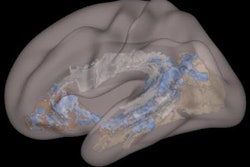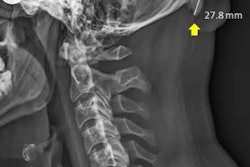
Are young adults really growing "horns" from excessive smartphone use? Skeptics are questioning a 2018 study that claimed to find bony protuberances on the skulls of young men -- growths that the authors hypothesized were connected to excessive mobile device use.
Australian researchers studied x-rays of 1,200 individuals ages 18 to 86, finding that those who were male, younger, and had a higher degree of forward head protraction were more likely to also have enlarged external occipital protuberances at the base of their skulls. The authors speculated that these protuberances developed as a musculoskeletal response to heavy mobile device use as the body compensated for the head's heavier weight in the forward position.
The study languished largely unnoticed after being published in February 2018 in the Nature journal Scientific Reports. But that changed last week after the BBC published an article titled "How modern life is transforming the human skeleton."
The BBC article gave heavy credence to the theory connecting the protuberances to mobile device use; secondary coverage of the article in the lay press dubbed the protuberances "horns," and an internet sensation was born.
A backlash soon developed to the claims. Most of the criticism centered around the prevalence of the protuberances in men, which the Australian team attributed to heavier mobile device use in males. Actually, it's well known in anthropology circles that men have a larger, rougher area on the back of the skull, according to a June 20 article in Forbes.
A further criticism of the Scientific Reports paper was that it lacked data or a table of results, other than a graph of protuberance differences between men and women -- a graph that the Forbes article claims was incorrect. A number of researchers raised questions about other assumptions made by the Australian authors, and some even questioned how the paper made it through the peer-review process.
it would have been better had the authors somehow quantified cell phone use, rather than make the assumption that younger people look down at their cell phones more than older people. but, at least it's not a totally crazy assumption, just not scientific.
— Kimberly Hickok (@kimdhickok) June 20, 2019
Radiologists were also quick to weigh in on the phenomenon.
“Extraordinary claims require extraordinary evidence”. One could’ve looked for a correlation between phone usage and this growth before blindly speculating such a relationship. Thankfully there are twitter radiologists to quickly debunk! https://t.co/a6MMQ2qHkj
— Matthew Budde (@buddemd) June 21, 2019
And a few wags in the Twitterverse couldn't resist making light of the hullaballoo.
I think the horn is real, but the relationship is off. Actually caused by the increased weight of the world being carried on the shoulders of millennials
— Philip R. Chapman, MD (@PhilipRChapman1) June 21, 2019



















